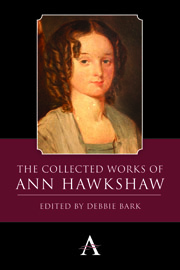Book contents
- Frontmatter
- Contents
- Preface and Acknowledgements
- Biographical Introduction
- 1842: ‘Dionysius the Areopagite’, with Other Poems
- 1843: Life's Dull Reality
- 1847: Poems for My Children
- 1854: Sonnets on Anglo-Saxon History
- 1871: Cecil's Own Book
- Appendix A
- Appendix B
- Bibliography
- Index of Titles
- Index of First Lines
1854: Sonnets on Anglo-Saxon History
Published online by Cambridge University Press: 05 May 2014
- Frontmatter
- Contents
- Preface and Acknowledgements
- Biographical Introduction
- 1842: ‘Dionysius the Areopagite’, with Other Poems
- 1843: Life's Dull Reality
- 1847: Poems for My Children
- 1854: Sonnets on Anglo-Saxon History
- 1871: Cecil's Own Book
- Appendix A
- Appendix B
- Bibliography
- Index of Titles
- Index of First Lines
Summary
Sonnets on Anglo-Saxon History was published in November 1854 by the London publisher John Chapman and attracted largely favourable reviews. Hawkshaw's sequence of one hundred sonnets retells the history of Britain from the advent of its earliest inhabitants through to the Norman Conquest. In both form and broad subject matter, Sonnets on Anglo-Saxon History responds to William Wordsworth's poetic survey of Church history, Ecclesiastical Sketches. First published in 1822, then revised, expanded and renamed Ecclesiastical Sonnets in 1845, Wordsworth's sequence of 132 sonnets is divided into 3 parts covering church history from its introduction to Britain through to the early nineteenth century. Hawkshaw is responding specifically to the 39 sonnets that make up part 1 of Ecclesiastical Sketches (‘From the Introduction of Christianity into Britain, to the Consummation of the Papal Dominion’), which begins with paganism in prehistoric Britain, moves chronologically through to the Norman Conquest and the Crusades, and ends with the reign of King John (1199—1216). Hawkshaw's sequence ends at the Norman Conquest (1066). Technically challenging to execute and requiring extensive depth of research, Hawkshaw's accomplishment is remarkable, particularly as Wordsworth's use of the sonnet sequence to capture an historical narrative is often considered to be unique.
Of the 100 sonnets in Sonnets on Anglo-Saxon History, 98 are faced on the page by a short prose extract from the work of prominent contemporary historians of the Anglo-Saxon period, or from early nineteenth-century translations of Anglo-Saxon texts.
- Type
- Chapter
- Information
- The Collected Works of Ann Hawkshaw , pp. 167 - 368Publisher: Anthem PressPrint publication year: 2014

